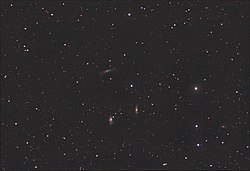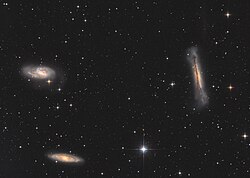Trojice galaxií ve Lvu
| Trojice galaxií ve Lvu | |
|---|---|
 Skupina M66: M65 je vpravo nahoře, M66 vpravo dole a NGC 3628 je vlevo. Sever je vlevo. | |
| Pozorovací údaje (Ekvinokcium J2000,0) | |
| Rektascenze | 11h 19m 41,3s[1] |
| Deklinace | +13°11′43″[1] |
| Souhvězdí | Lev (Leo) |
| Vzdálenost | 35 Mly[2][3] |
| Fyzikální charakteristiky | |
| Počet galaxií | 3-5[4][5][6][2] |
| Nejjasnější galaxie | Messier 66[4][5] |
| Označení v katalozích | |
| M 66 Group,[2] Arp 317[7][1] LGG 231,[1] Leo I Group,[1] NOGG P1 533,[5] NOGG P2 543[5] | |
Trojice galaxií ve Lvu (také známá jako Lví trojče nebo skupina M66) je malá skupina 3-5 galaxií vzdálená od Země přibližně 35 milionů světelných let.[2] Na obloze se nalézá v souhvězdí Lva a tvoří ji 3 spirální galaxie: Messier 65, Messier 66 a NGC 3628.
Členové skupiny
Následující tabulka ukazuje ty členy skupiny, na kterých se shodují Nearby Galaxies Catalog,[6] Lyons Groups of Galaxies (LGG) Catalog[4] a tři seznamy této skupiny vytvořené při průzkumu Nearby Optical Galaxies.[5]
| Název | Typ[8] | R.A. (J2000)[8] | Dec. (J2000)[8] | Rudý posuv (km/s)[8] | Magnituda[8] |
|---|---|---|---|---|---|
| M65 | SAB(rs)a | 11h 18m 56,0s | +13°05′32″ | 807 ± 3 | 10,3 |
| M66 | SAB(s)b | 11h 20m 15,0s | +12°59′30″ | 727 ± 3 | 9,7 |
| NGC 3628 | SAb pec | 11h 20m 17,0s | +13°35′23″ | 843 ± 1 | 9,4 |
Některé výše zmíněné prameny uvádí, že do skupiny může patřit další jedna nebo dvě galaxie. Nejčastěji bývá uváděn jako další člen skupiny galaxie NGC 3593.
Blízké skupiny galaxií
Fyzicky blízko trojice ve Lvu se nachází Skupina galaxií M 96.[9] Tyto dvě skupiny mohou být oddělené části jiné mnohem větší skupiny,[9] ovšem některé studie považují trojici ve Lvu za součást Skupiny galaxií M96.[5][10]
Galerie obrázků
Snímek trojice ve Lvu a vzdálenějších galaxií z dalekohledu VST.[11] Tento obrázek ukazuje možnosti nového přístroje určeného k průzkumu vzdáleného vesmíru.
Reference
V tomto článku byl použit překlad textu z článku Leo Triplet na anglické Wikipedii.
- ↑ a b c d e NASA/IPAC Extragalactic Database: Results for ARP 317 [online]. [cit. 2017-01-10]. Dostupné online. (anglicky)
- ↑ a b c d FROMMERT, Hartmut. The Leo Triplett (M66 group) [online]. 1999-10-24 [cit. 2018-01-10]. Dostupné online. (anglicky)
- ↑ POWELL, Richard. Atlas of the Universe: The Leo I Group [online]. [cit. 2018-01-10]. Dostupné online. (anglicky)
- ↑ a b c GARCIA, A. General study of group membership. II - Determination of nearby groups. S. 47–90. Astronomy and Astrophysics Supplement [online]. Červenec 1993 [cit. 2018-01-10]. Roč. 100, s. 47–90. Dostupné online. Bibcode:1993A&AS..100...47G. (anglicky)
- ↑ a b c d e f GIURICIN, Giuliano; MARINONI, Christian; CERIANI, Lorenzo, et al. Nearby Optical Galaxies: Selection of the Sample and Identification of Groups. S. 178–194. Astrophysical Journal [online]. Listopad 2000 [cit. 2018-01-10]. Roč. 543, čís. 1, s. 178–194. Dostupné online. arXiv:astro-ph/0001140. DOI:10.1086/317070. Bibcode:2000ApJ...543..178G. (anglicky)
- ↑ a b TULLY, R. B. Nearby Galaxies Catalog. Cambridge: Cambridge University Press, 1988. ISBN 0-521-35299-1.
- ↑ ARP, Halton. Atlas of Peculiar Galaxies. S. 1. Astrophysical Journal Supplement [online]. Listopad 1966 [cit. 2018-01-10]. Roč. 14, s. 1. Dostupné online. DOI:10.1086/190147. Bibcode:1966ApJS...14....1A. (anglicky)
- ↑ a b c d e NASA/IPAC Extragalactic Database: Results for Various Galaxies [online]. [cit. 2017-11-02]. Dostupné online. (anglicky)
- ↑ a b FERRARESE, Laura; FORD, Holland C.; HUCHRA, J., et al. A Database of Cepheid Distance Moduli and Tip of the Red Giant Branch, Globular Cluster Luminosity Function, Planetary Nebula Luminosity Function, and Surface Brightness Fluctuation Data Useful for Distance Determinations. S. 431–459. Astrophysical Journal Supplement [online]. Červen 2000 [cit. 2018-01-10]. Roč. 128, čís. 2, s. 431–459. Dostupné online. arXiv:astro-ph/9910501. DOI:10.1086/313391. Bibcode:2000ApJS..128..431F. (anglicky)
- ↑ FOUQUE, P.; GOURGOULHON, E.; CHAMARAUX, P., et al. Groups of galaxies within 80 Mpc. II - The catalogue of groups and group members. S. 211–233. Astronomy and Astrophysics Supplement [online]. Květen 1992 [cit. 2018-01-10]. Roč. 93, čís. 2, s. 211–233. Dostupné online. Bibcode:1992A&AS...93..211F. (anglicky)
- ↑ Pohled dalekohledem VST na 'Leo Triplet' a ještě dál [online]. Evropská jižní observatoř, 2011-07-27 [cit. 2018-01-10]. Dostupné online.
Externí odkazy
 Obrázky, zvuky či videa k tématu Trojice galaxií ve Lvu na Wikimedia Commons
Obrázky, zvuky či videa k tématu Trojice galaxií ve Lvu na Wikimedia Commons - SIMBAD Astronomical Database: Results for M 66 Group [online]. [cit. 2018-01-10]. Dostupné online. (anglicky)
- NASA - APOD. Astronomický snímek dne - Trojice ve Lvu [online]. astro.cz, 2017-04-12 [cit. 2018-01-10]. Dostupné online.
- FROMMERT, Hartmut. The Leo Triplett (M66 group) [online]. 1999-10-24 [cit. 2018-01-10]. Dostupné online. (anglicky)
- POWELL, Richard. Atlas of the Universe: The Leo I Group [online]. [cit. 2018-01-10]. Dostupné online. (anglicky)
Média použitá na této stránce
Autor: ESO/INAF-VST/OmegaCAM. Acknowledgement: OmegaCen/Astro-WISE/Kapteyn Institute, Licence: CC BY 3.0
Triplet of bright galaxies in the constellation of Leo (The Lion), together with a multitude of fainter objects: distant background galaxies and much closer Milky Way stars. The image hints at the power of the VST and OmegaCAM for surveying the extragalactic Universe and for mapping the low brightness objects of the galactic halo. This image is a composite created by combining exposures taken through three different filters. Light that passed through a near-infrared filter was coloured red, light in the red part of the spectrum is coloured green, and green light is coloured magenta.
Autor: Marekmazuch, Licence: CC BY-SA 4.0
pořízeno amatérským dalekohledem z města. expozice cca 12hodin
Autor: Stub Mandrel, Licence: CC BY-SA 3.0
The Leo Triplet imaged using a Canon 450D with a 400mm telephoto lens. Stack of 19 2-minute images at iso 1600. As well as the three main galaxies M65, M66 and NGC3628, over 70 other galaxies can be identified in this image - notably NGC3593 at right.






